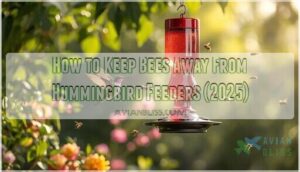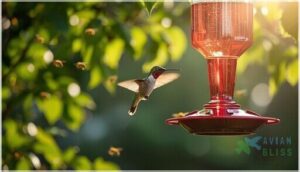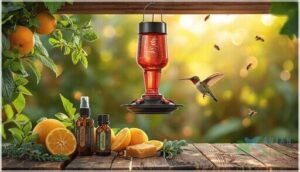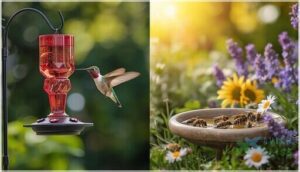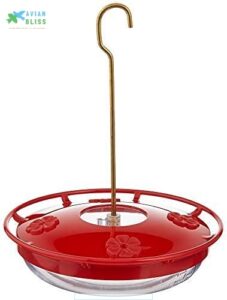This site is supported by our readers. We may earn a commission, at no cost to you, if you purchase through links.
Your hummingbird feeder transforms into a buzzing landing pad each summer, and it’s not because bees are confused. These pollinators detect sugar solutions from considerable distances—honeybees can forage up to four miles from their hives when floral resources run low.
During late summer, when wildflowers become scarce and bee colonies hit peak population, your feeder’s sweet nectar becomes an irresistible target. The problem intensifies when feeders leak or drip, creating scent trails that recruit entire foraging squads.
You don’t need to abandon your feeder or harm these essential pollinators, though. Simple adjustments to feeder design, placement, and maintenance can redirect bees toward better food sources while keeping your hummingbirds well-fed and happy.
Table Of Contents
- Key Takeaways
- Why Bees Are Attracted to Hummingbird Feeders
- Effective Ways to Keep Bees Away
- Balancing Hummingbird and Bee Needs
- Top 5 Products to Deter Bees From Feeders
- Frequently Asked Questions (FAQs)
- Are hummingbird feeders bee-proof?
- Do hummingbirds eat feeders?
- What insects eat hummingbird feeders?
- Which hummingbird feeder is best?
- Is it okay for bees to drink from a hummingbird feeder?
- How do I stop bees on my hummingbird feeder?
- Why are bees suddenly swarming my hummingbird feeder?
- How to deter wasps from a hummingbird feeder?
- How often should I change sugar water ratios seasonally?
- Do bees remember feeder locations after winter migration?
- Conclusion
Key Takeaways
- Bees swarm hummingbird feeders primarily during late summer when natural wildflowers become scarce and bee colonies reach peak population, making your feeder’s sugar water an irresistible alternative food source.
- Saucer-style feeders with red coloring and built-in bee guards work best because they keep nectar below where bees can reach it while the red hue attracts hummingbirds but doesn’t register strongly in bees’ visual spectrum.
- Regular maintenance every 3-5 days, strategic placement in shaded areas, and frequent feeder relocation disrupt bees’ ability to remember nectar locations while preventing the sticky drips and fermentation that attract entire foraging squads.
- Planting bee-friendly flowers like lavender and sunflowers at least four feet away from your feeders creates a win-win solution that supports essential pollinators while naturally redirecting them from competing with hummingbirds.
Why Bees Are Attracted to Hummingbird Feeders
You’ve set up your feeder with care, but bees still show up in droves. Understanding why they’re drawn to your hummingbird feeder helps you choose the right solutions.
Let’s look at the main reasons bees can’t resist that sweet nectar you’ve put out.
Shared Attraction to Sugary Nectar
Nectar sugar content draws both bees and hummingbirds to your feeders. You’re basically offering a 4-to-1 water-sugar solution that both creatures need for energy. Here’s why bees keep showing up:
Feeders with yellow accents can attract unwanted pests.
- Floral scarcity impact drives bees to feeders when natural blooms aren’t available
- Warm weather effect intensifies their visits during hot months
- Nectar composition with high sucrose appeals to both species
- Alternative sugar sources become scarce seasonally
- Exposed nectar leaks create irresistible scent trails
Types of Bees Commonly Found at Feeders
You’ll spot several bee species vying for feeder access. Honeybees dominate visits, especially in late summer when their colonies peak. Bumblebees arrive less frequently but handle feeders easily due to their size. Smaller mining bees and metallic sweat bees slip through openings during warm weather.
Understanding these pollinator diversity patterns helps you choose effective bee guards for deterring bees from hummingbird feeders. To minimize bee attraction, consider using bee proof feeders that prevent nectar from touching the outside.
| Bee Species | Nectar Preferences | Bee Behavior | Hive Management |
|---|---|---|---|
| Honeybees | High sucrose solutions | Forage 2-4 miles from hives | Peak populations late summer |
| Bumblebees | Prefer flowers, visit feeders | Larger, less aggressive | Active during warm months |
| Mining Bees | Early season nectar | Solitary ground-nesters | Less problematic presence |
| Sweat Bees | Sugar water attraction | Small, access tiny openings | Increase in urban areas |
Feeder Design and Color Influences
Beyond which bees show up, feeder design and color contrast play a huge role in attraction. Red hummingbird feeders work best since bees don’t see red well, while yellow components act like billboards to them.
Feeder port size matters too—ports under 1/10 inch block bees but let hummingbirds feed. Bee guards and pan-style feeding ports keep nectar access below where bees can reach, while leak-free feeder material prevents sticky drips.
Seasonal Factors Affecting Bee Visits
Bee behavior shifts dramatically with the seasons, and that affects your feeder. Late summer brings the biggest challenge—when drought conditions shrink floral availability and hive demands peak, bees swarm feeders like never before.
Three patterns drive seasonal bee visits:
- Temperature effects – Bees forage most actively between 55°F and 95°F
- Seasonal scarcity – Natural nectar dries up in hot, dry months
- Weather patterns – Rain temporarily reduces bee activity at feeders
Effective Ways to Keep Bees Away
You don’t have to wage war on bees to protect your hummingbird feeder. A few simple changes to your setup can make all the difference in keeping those feeders buzzing with wings instead of stingers.
Here are the most effective strategies that work without harming these important pollinators.
Choosing Bee-Proof Feeder Designs
The right feeder design can make all the difference when you’re trying to protect your hummingbirds. Saucer feeders work well because their flat design keeps nectar below where bees can reach. Look for feeders with red visual cues instead of yellow, as bees gravitate toward brighter colors. Material durability matters too—sturdy glass or polycarbonate reinforces built-in bee deterrents effectively.
| Feeder Type | Why It Works |
|---|---|
| Saucer feeders | Nectar sits below bee access range |
| Tube feeders with narrow ports | Feeder port size excludes bees |
| Red-colored designs | Visual cues attract hummers, not bees |
Nectar concentration and shady placement also influence bee visits, but choosing the right structure gives you a solid foundation.
Installing Bee Guards and Nectar Protectors
When bees keep crashing your hummingbird party, bee guards and nectar protectors offer a practical fix. These small plastic screens or mesh pieces fit over feeding ports, blocking bees while letting hummingbird tongues slip through easily.
You’ll find add-ons under $10 that snap right onto most feeders. Guard effectiveness improves when you combine installation with regular cleaning—wiping away sticky residue stops bees from finding their way back.
Adjusting Feeder Placement and Maintenance
Where you hang your feeder matters as much as the feeder itself. Smart feeder placement and consistent feeder maintenance work together to discourage bees without harming them.
- Position feeders in shaded areas—bees prefer sunny spots while hummingbirds tolerate shade well
- Move feeders every few days (feeder relocation) to disrupt bees’ memory of nectar flow locations
- Clean feeders every 3-5 days with hot water to prevent fermentation that attracts insects
- Check for leaks that create bee deterrents issues by drawing swarms from distances
- Keep cleaning hummingbird feeders away from flower beds to separate nectar sources
Using Natural Bee Deterrents Safely
Natural scents like essential oils offer a gentle way of deterring bees without chemicals. Plant-based deterrents, including citrus peels, create barriers bees avoid.
You can apply peppermint or eucalyptus oil around—not on—feeders, since oil application safety matters for both birds and insects. Safe dosages matter, so dilute properly.
Soap spray recipes combining castile soap with water work well too. Store homemade bee repellents in cool places for deterrent storage efficacy.
Balancing Hummingbird and Bee Needs
You don’t have to choose between hummingbirds and bees—both are valuable pollinators that deserve support in your yard. The key is creating separate spaces where each can thrive without competing for the same food source.
You don’t have to choose between hummingbirds and bees—create separate spaces where both valuable pollinators can thrive without competing
Here are four practical ways to keep everyone happy and well-fed.
Providing Alternative Nectar Sources for Bees
Think of your garden as a natural traffic controller—when you provide alternative nectar sources, you’re guiding bees toward their own dining spots. Seasonal planting of native flowers like bee balm, lavender, and sunflowers creates a nutritional impact that strengthens colony health.
Consider these strategies to support floral diversity:
- Plant late-season bloomers like zinnias to sustain bees during nectar scarcity
- Include large nectar producers such as basswood trees for abundant food
- Use pollen substitutes during natural shortages to boost brood development
- Create diverse plantings mixing native and non-native bee-friendly flowers
This approach keeps bees happily foraging away from your hummingbird feeders.
Planting Bee-Friendly Flowers Away From Feeders
Placement effects matter more than you’d think. Position bee-friendly flowers like mountain mint and bee balm at least four feet from your hummingbird feeders to redirect foraging behavior. This strategic distance maintains ecological balance by giving bees their preferred nectar sources while keeping them away from feeders.
Near feeders, choose less attractive options like red tulips or carnations that won’t compete for bee attention in your pollinator garden.
Maintaining a Healthy Pollinator Garden
Your yard’s long-term habitat challenges become manageable once you understand seasonal garden upkeep. Spring through fall, rotate bee-friendly flowers to maintain nectar source diversity for pollinator insects.
This plant variety support creates stable pollinator gardens that deliver ecosystem economic benefits—about $577 billion annually in pollination services. Overlapping bloom times guarantee pollinator health in gardens while keeping bees naturally occupied away from your feeders.
Avoiding Harmful Chemicals and Pesticides
While diverse plantings help, avoiding pesticides protects both bees and hummingbirds from chemical impacts. Neonicotinoid insecticides contaminate nectar and reduce bee populations by 43% in treated areas.
You’ll find safe alternatives for garden pest management—biological controls work in 78% of pest cases without harming pollinator health. Organic gardening practices and pesticide-free yards create true pollinator protection, keeping your feeders safe for all visitors.
Top 5 Products to Deter Bees From Feeders
You don’t have to fight off bees on your own. Several well-designed feeders and accessories can help you keep bees at bay while still welcoming hummingbirds.
Here are five products that have proven effective at deterring bees from your feeders.
1. Hummingbird High View Feeder
This feeder’s design features a saucer-style construction that keeps nectar below the feeding ports, where bees can’t reach it. The 12-ounce capacity includes four ports with built-in ant moat insect deterrence. Adding bee guards enhances its effectiveness at keeping bees away from your hummingbird feeder.
You’ll appreciate the red color scheme, which attracts hummingbirds while bees naturally prefer yellow.
User feedback consistently highlights its drip-proof construction and easy cleaning maintenance tips. Market insights show it’s priced around $30 to $40, backed by a lifetime guarantee.
2. Hummingbird Nectar Guard Tips Clear
These simple plastic tips slip onto your feeder’s ports and work like a protective gate. When a hummingbird inserts its beak, the flexible membrane opens, then closes immediately after feeding. Bees can’t penetrate this barrier, so your nectar stays clean and your birds stay safe.
The twelve clear guard tips fit most Aspects feeders, including HummZinger models. You’ll notice fewer bees immediately, though proper feeder maintenance and guard installation matter. They’re an affordable bee deterrent method that really works for keeping bees away from hummingbird feeders.
3. Perky Pet Hummingbird Glass Feeder
With its built-in bee guards and ant moat, this PerkyPet glass feeder addresses two common problems at once. The four feeding ports feature protective barriers that block bees while allowing hummingbirds easy access to the eight ounces of nectar inside.
You’ll appreciate the clear glass materials that let you monitor nectar levels, and the unscrewing base makes hummingbird feeder maintenance straightforward.
The design keeps bees away effectively, though you’ll want to clean it regularly to prevent mold in warm weather.
4. Heath Yellow Butterfly Bliss Feeder
This decorative steel-and-glass option catches the eye, but here’s the catch: it doesn’t include bee guards or specialized bee deterrent methods. The yellow color actually attracts bees alongside birds, and its open glass bowl design gives insects easy access to any sugary contents.
If you’re using it for fruit or jelly rather than nectar, you’ll manage pollinator balance better. For dedicated hummingbird feeders requiring serious bee nectar station separation, consider models with built-in protections.
Regular hummingbird feeder maintenance helps, though garden management becomes essential with this feeder design.
5. Yellow Glass Birdbath Feeder Stake
This decorative garden piece looks beautiful but works against your bee management goals. The bright yellow glass and open basin design attract bees just as much as hummingbirds, and there’s no bee guard to protect the water. Without proper bee deterrent methods, you’re basically creating a bee buffet.
While stake durability and aesthetic appeal are solid, glass maintenance becomes tricky with nectar residue buildup.
If you’re serious about keeping yellow jackets away from hummingbird feeders, skip this birdbath entirely and choose feeders with built-in protections instead.
Frequently Asked Questions (FAQs)
Are hummingbird feeders bee-proof?
No feeder design guarantees complete bee exclusion. While bee guards and specialized ports effectively reduce access, bees may still investigate due to nectar scent, residual sweetness, or minor drips on surfaces.
Do hummingbirds eat feeders?
No, hummingbirds don’t eat feeders themselves. They consume the sugar water inside, drinking up to seven grams daily.
Your feeder provides critical nectar that can supply roughly 70% of their energy needs.
What insects eat hummingbird feeders?
Wasps, ants, and yellowjackets routinely consume sugar water from your feeders. These insects use their mouthparts to access nectar, potentially spreading disease.
Hornets and occasional beetles may also visit when natural food sources decline during warm months.
Which hummingbird feeder is best?
The best option combines red saucer feeder design with built-in bee guard ports and ant moats.
Look for dish feeders with easy cleaning access, leak-proof construction, and adequate feeder capacity to minimize refills while maximizing hummingbird visits.
Is it okay for bees to drink from a hummingbird feeder?
There’s wisdom in the saying “live and let live.” Yes, bees can safely drink from your feeder. They’re essential pollinators seeking nectar sources.
Focus on coexistence strategies and feeder hygiene to balance pollinator needs without harming either species.
How do I stop bees on my hummingbird feeder?
You can deter bees from hummingbird feeders using bee guards, relocating feeders to shaded spots, applying safe repellent options like peppermint oil, and maintaining strict cleaning frequency to remove residue attracting insects.
Why are bees suddenly swarming my hummingbird feeder?
When late summer arrives, natural nectar sources dry up just as honeybee colonies hit their peak population.
Your feeder becomes the neighborhood buffet, drawing sudden bee swarms competing desperately for scarce sugary resources.
How to deter wasps from a hummingbird feeder?
Wasp deterrents work through strategic trap placement near your feeder, safe solutions like vinegar wipes, and feeder modifications.
You can deter bees and yellow jackets by providing habitat balance—planting alternative nectar sources away from feeding stations.
How often should I change sugar water ratios seasonally?
Think of it as fine-tuning a recipe: adjust sugar ratios seasonally based on temperature. Use 1:4 in summer for nectar stability, 1:3 in winter for energy, changing sugar water every 1-7 days depending on heat.
Do bees remember feeder locations after winter migration?
Yes, bees possess strong spatial memory that allows them to recall feeder locations after winter. Their cognitive mechanisms and foraging behavior help them reorient to familiar nectar sources once spring activity resumes.
Conclusion
The best defense against bees at your hummingbird feeder is actually welcoming them—just somewhere else. When you combine leak-proof feeders with a thriving pollinator garden nearby, both species flourish without competing.
Your maintenance routine matters more than any single product: clean ports prevent drips, proper placement reduces discovery, and alternative nectar sources give bees better options. These small adjustments protect hummingbirds while supporting the pollinators your garden desperately needs.

